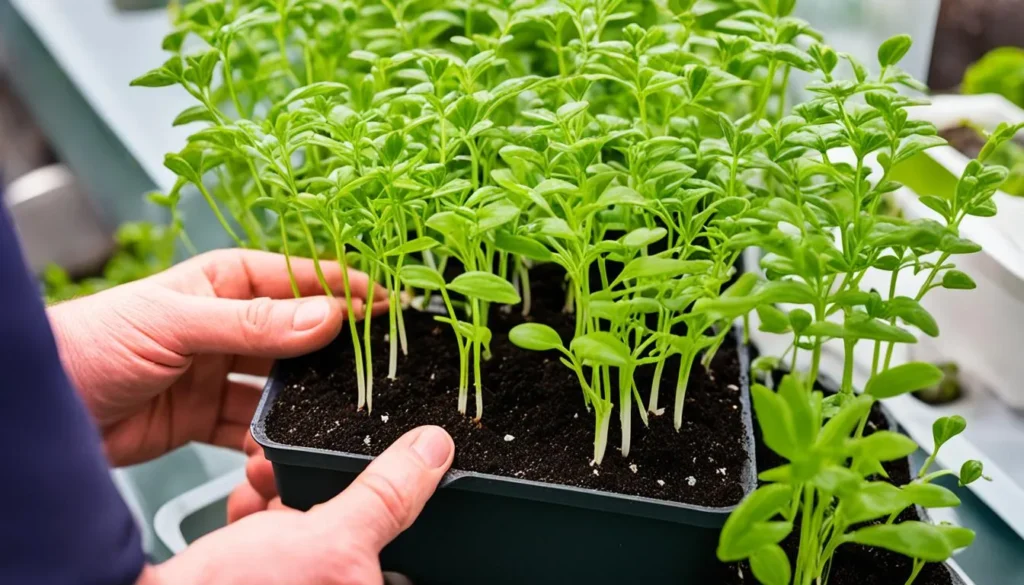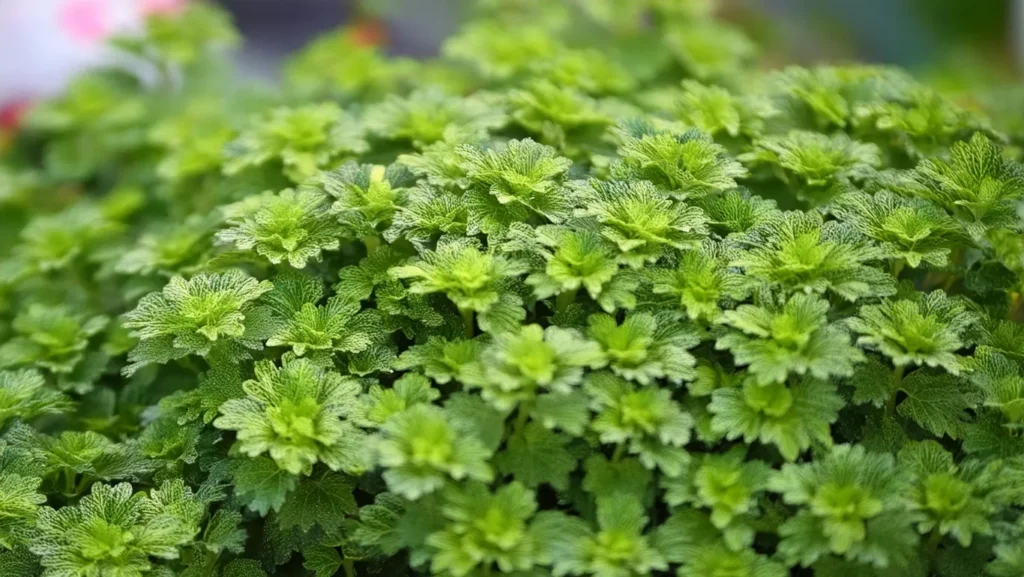In this comprehensive guide, we will explore the cultivation and care of Micranthemum ‘Monte Carlo’, commonly known as Monte Carlo Pearlweed.
Whether you’re an experienced aquarist or just starting out, this guide will provide you with all the necessary information to cultivate and maintain this beautiful aquarium plant successfully.
Micranthemum ‘Monte Carlo’ is a versatile freshwater plant highly sought after for its lush, carpet-like growth. Its small, rounded leaves and vibrant green color make it a popular choice for aquascaping enthusiasts.
With proper care and attention, you can create a stunning underwater landscape in your aquarium using Monte Carlo Pearlweed.
Throughout this guide, we will cover the origins and natural habitat of Monte Carlo Pearlweed, the ideal setup for your aquarium, planting techniques for beautiful aquascapes, propagation and cultivation methods, troubleshooting common plant issues, selecting complementary tank mates, and pruning and trimming techniques.
By the end, you will have all the knowledge you need to cultivate and care for this remarkable plant species.

Key Takeaway
- Monte Carlo Pearlweed, also known as Micranthemum ‘Monte Carlo,’ is a sought-after freshwater carpet plant.
- It features small, rounded leaves and a vibrant green color, perfect for creating lush aquascapes.
- Understanding its origins and natural habitat can help replicate ideal growing conditions.
- Proper aquarium setup, lighting, substrate, and water parameters are crucial for successful cultivation.
- Planting techniques, propagation methods, and pruning are essential for maintaining healthy and vibrant plants.
Quick Stats
| Attribute | Details |
| Family Name | Linderniaceae |
| Origin | Argentina |
| Height | 2-5 cm (0.8-2 inches) |
| pH Range | 6.0 – 7.5 |
| CO2 Requirement | Low to Moderate |
| Growth Rate | Fast |
| Care Level | Easy to Moderate |
| Color Form | Bright Green |
| Water Conditions | 20-26°C (68-79°F), adaptable to a wide range of water hardness |
| Max Size | Forms a dense carpet across the substrate |
| Lighting | Moderate to High |
| Supplements | Benefits from CO2 supplementation and liquid fertilizers |
| Placement | Foreground |
| Propagation | Splitting and replanting dense mats |
What Is Micranthemum ‘Monte Carlo’?
Micranthemum ‘Monte Carlo’ is a popular aquarium plant known for its versatility and beauty. It is characterized by its small, rounded leaves and vibrant green color.
This low-growing carpet plant can form dense mats across the substrate, creating a lush and natural look in your aquarium. Its compact growth and adaptability make it suitable for a variety of aquascaping styles and tank sizes.

Origins And Natural Habitat
- Micranthemum ‘Monte Carlo’ is native to South America and was originally discovered in the Monte Carlo region of Argentina. This aquatic plant can be found growing along the banks of streams, rivers, and in marshes, where it thrives in its natural habitat.
- Monte Carlo Pearlweed is well-adapted to a variety of water conditions, including both soft and hard water. Understanding the origins and natural habitat of Micranthemum ‘Monte Carlo’ is important for recreating the ideal conditions for its growth in your aquarium.
- To replicate the natural habitat of Monte Carlo Pearlweed in your aquarium, you must provide appropriate water parameters, substrate, and lighting. By recreating these conditions, you can ensure this beautiful aquatic plant’s optimal growth and health.
Physical Characteristics
- Stem Structure: Monte Carlo exhibits thin and delicate stems that spread horizontally across the substrate, creating a dense mat-like appearance.
- Leaf Appearance: The plant’s small, rounded leaves are a vibrant shade of green and possess a glossy sheen, adding to its aesthetic appeal. These leaves densely cover the stems, contributing to the carpet effect.
- Leaf Size and Shape: Each leaf typically measures between 5 to 8 millimeters in diameter. Their rounded shape and compact arrangement facilitate the formation of a thick carpet.
- Growth Habit: Monte Carlo has a prostrate growth habit, meaning it grows close to the substrate rather than vertically. As it spreads horizontally, it forms a dense carpet that enhances the visual impact of the aquarium.
Optimizing Lighting And Substrate
Proper lighting and substrate are vital for the successful growth of Monte Carlo Pearlweed. Ensure your aquarium receives moderate to high lighting levels of around 3 to 5 watts per gallon. You can use LED lights specifically designed for planted aquariums.
Additionally, choose a nutrient-rich substrate, such as aqua soil or nutrient-rich gravel, to provide essential nutrients for the plant’s growth.

Water Parameters For Healthy Growth
Maintaining the right water parameters is crucial for the healthy growth of Monte Carlo Pearlweed. The following are the ideal conditions:
- Temperature: Keep the water temperature between 72°F and 78°F (22°C – 26°C).
- pH: Aim for a slightly acidic to neutral pH level between 6.0 and 7.5.
- Hardness: Provide moderately soft to moderately hard water with a GH (general hardness) level between 3 and 8.
Temperature Needs
- Optimal Temperature: Monte Carlo flourishes in temperatures ranging from 72°F to 78°F (22°C to 26°C). Maintaining the aquarium within this temperature range provides an ideal environment for the plant’s growth and development.
- Tolerance: While Monte Carlo prefers temperatures within the optimal range, it can tolerate slight fluctuations. However, prolonged exposure to temperatures outside the recommended range may affect its growth rate and overall health.
- Stability: Consistency in temperature is crucial for promoting healthy growth and preventing stress in Monte Carlo. Avoid rapid temperature fluctuations, as they can negatively impact the plant and make it more susceptible to disease and algae.
- Monitoring: Regularly monitor the aquarium’s temperature using a reliable thermometer. Adjust heating or cooling equipment as needed to maintain the desired temperature range and ensure the well-being of Monte Carlo and other aquatic inhabitants.
Placement Option
- Foreground Planting: Monte Carlo is often used as a foreground plant due to its low-growing nature and ability to form dense carpets. Planting it in the foreground creates a lush carpeting effect that enhances the visual depth of the aquarium. Place it along the front glass or in areas of the substrate where it will receive ample light.
- Carpeting Effect: To achieve a full carpeting effect, plant Monte Carlo densely across the substrate. Ensure even spacing between individual stems to encourage uniform growth and prevent overcrowding. Regular pruning may be necessary to maintain the desired carpet thickness and prevent vertical growth.
- Aquascape Focal Point: Monte Carlo can also be strategically placed to serve as a focal point in the aquascape. Create pathways or open areas within the carpet where the plant is denser, leading the viewer’s eye toward other aquarium features or focal points.
- Background Accent: While Monte Carlo is primarily used in the foreground, it can also be utilized as a background accent plant in nano or small aquariums. Planting it along the back or sides of the aquarium can add depth and visual interest to the aquascape without overwhelming larger plants or decorations.
Recommended Tank Size And Layout
When choosing a tank for Monte Carlo Pearlweed, it is essential to consider the recommended tank size and layout. A larger tank with a capacity of at least 10 gallons is ideal as it provides ample space for the plant to spread and thrive.
In terms of layout, consider creating a foreground or midground carpet effect by planting Monte Carlo Pearlweed densely in the desired area.

Complementary Tank Mates For A Harmonious Aquarium
Creating a harmonious aquarium involves carefully selecting compatible tank mates for your Monte Carlo Pearlweed. Micranthemum ‘Monte Carlo’ can coexist with various fish and invertebrate species without causing harm or interfering with its growth.
When choosing tank mates, it’s important to consider factors such as temperament, size, and water parameter compatibility. By selecting the right tank mates, you can create a thriving and visually appealing ecosystem in your aquarium.
To ensure a harmonious environment, here are some suitable tank mates for Monte Carlo Pearlweed:
- Neon Tetra
- Cherry Shrimp
- Betta Fish (Siamese Fighting Fish)
- Otocinclus Catfish
- Ember Tetra
- Amano Shrimp
- Endler’s Livebearer
- Pearl Gourami
- Dwarf Corydoras
| Tank Mate | Temperament | Size | Water Parameters |
| Neon Tetra | Peaceful | 0.8-1.2 inches | Temperature: 72-78°F pH: 6.0-7.0 |
| Cherry Shrimp | Peaceful | 1-1.5 inches | Temperature: 72-78°F pH: 6.5-7.5 |
| Betta Fish (Siamese Fighting Fish) | Semi-aggressive | 2-3 inches | Temperature: 76-82°F pH: 6.5-7.5 |
| Otocinclus Catfish | Peaceful | 1-2 inches | Temperature: 72-82°F pH: 6.0-7.5 |
| Ember Tetra | Peaceful | 0.8 inches | Temperature: 72-82°F pH: 5.5-7.0 |
| Amano Shrimp | Peaceful | 1.5-2 inches | Temperature: 72-78°F pH: 6.0-7.5 |
| Endler’s Livebearer | Peaceful | 1-1.5 inches | Temperature: 72-82°F pH: 6.5-8.0 |
| Pearl Gourami | Peaceful | 3-4 inches | Temperature: 77-82°F pH: 6.5-7.5 |
| Dwarf Corydoras | Peaceful | 1-2 inches | Temperature: 72-80°F pH: 6.0-7.0 |

Nutritional Needs Of The Plant
Monte Carlo (Micranthemum tweediei ‘Monte Carlo’) has relatively low nutritional demands compared to some other aquarium plants, but it still requires essential nutrients to thrive. Here are the nutritional needs of Monte Carlo:
Macronutrients
- Nitrogen (N): Essential for protein synthesis and overall plant growth. Nitrogen can be obtained from fish waste, decaying organic matter, and nitrogen-based fertilizers.
- Phosphorus (P): Important for energy transfer within the plant and root development. Phosphorus can be sourced from fish waste, decaying plant matter, and phosphorus-containing fertilizers.
- Potassium (K): Facilitates water and nutrient uptake, regulates stomatal function, and aids in photosynthesis. Potassium is typically available in aquarium water and can also be supplemented through potassium-based fertilizers.
Micronutrients
- Iron (Fe): Essential for chlorophyll synthesis and overall plant health. Iron deficiency can manifest as yellowing or chlorosis of leaves. Iron can be supplemented through iron-rich fertilizers or substrate additives.
- Magnesium (Mg): Plays a crucial role in chlorophyll formation and enzyme activation. Magnesium is typically available in aquarium water and can be supplemented if deficient.
- Calcium (Ca): Important for cell wall structure and overall plant growth. Calcium can be obtained from tap water and can also be supplemented through calcium-rich substrates or fertilizers.
- Trace Elements: Includes nutrients such as zinc, manganese, copper, and boron, which are required in small amounts for various biochemical processes within the plant.
Monte Carlo Pearlweed Cultivation Tips
- CO2 Injection: Consider supplementing with CO2 injection to enhance plant growth and promote lush carpeting. Monte Carlo benefits from CO2 supplementation, which boosts photosynthesis and carbon uptake, leading to faster and healthier growth. CO2 injection can be particularly beneficial in high-light setups.
- Nutrient Supplementation: Ensure adequate nutrient levels for healthy growth. Use a comprehensive liquid fertilizer or dry fertilizers to provide essential nutrients such as nitrogen, phosphorus, potassium, iron, and trace elements. Regular dosing according to the needs of your aquarium plants will support Monte Carlo’s growth and vibrancy.
- Pruning: Regularly trim Monte Carlo to maintain its desired carpeting height and prevent overgrowth. Use sharp aquascaping scissors to trim any excess growth and encourage lateral spreading. Pruning also helps promote denser carpeting and prevents shading of lower leaves.
- Water Parameters: Maintain stable water parameters within the optimal range for Monte Carlo growth. Aim for a temperature range of 72-78°F (22-26°C), pH between 6.0-7.5, and moderate water hardness. Ensure good water circulation to prevent stagnant areas and promote nutrient distribution.
- Propagation: Monte Carlo propagates readily through runners that develop along the substrate. Allow runners to establish and form new plantlets, then trim and replant them to expand the carpeting. Regularly replanting new shoots will help maintain a lush and uniform carpet appearance.

Plant Propagation Tips
- Identify Runners: Monte Carlo typically sends out runners as it grows. These runners will develop tiny plantlets along their length, which can be used for propagation. Identify these runners as they emerge from the main plant.
- Wait for Plantlets to Develop: Allow the plantlets on the runners to develop roots of their own before separating them from the parent plant. This ensures that they have a better chance of survival when replanted.
- Separate Plantlets: Once the plantlets have developed a sufficient root system, carefully separate them from the parent plant. Gently detach them from the runner, ensuring that the roots remain intact.
- Prepare Planting Site: Before replanting the separated plantlets, prepare the planting site by ensuring that the substrate is nutrient-rich and well-aerated. Make small holes or depressions in the substrate to accommodate the plantlets.
Benefits Of Planting Monte Carlo Pearlweed
- Beautiful Carpeting: Monte Carlo forms a dense, low-growing carpet that adds visual appeal to the foreground of your aquarium. Its bright green foliage creates a lush carpeting effect that enhances the overall aesthetics of the tank.
- Oxygenation: Like all aquatic plants, Monte Carlo contributes to oxygenation of the aquarium water during photosynthesis. This helps maintain a healthy environment for fish and other aquatic inhabitants by ensuring adequate oxygen levels.
- Nitrate Removal: Monte Carlo, like other aquatic plants, absorbs nitrates from the water as it grows. By utilizing nitrates as a nutrient source, it helps reduce nitrate levels in the aquarium, contributing to improved water quality and reducing the risk of algae overgrowth.
- Habitat for Fry and Invertebrates: The dense carpet created by Monte Carlo provides shelter and hiding places for fry (baby fish) and small invertebrates. This can be especially beneficial in breeding setups or community tanks where fry need protection from larger fish.
- Algae Control: A healthy carpet of Monte Carlo can help prevent algae growth by outcompeting algae for nutrients and light. Its dense growth can shade the substrate, reducing available light for algae to photosynthesize.

Conclusion
The cultivation and care of Monte Carlo Pearlweed, also known as Micranthemum ‘Monte Carlo,’ can bring beauty and depth to your aquascape.
This comprehensive guide has provided you with the necessary knowledge and understanding to successfully cultivate and maintain this popular freshwater plant in your aquarium.
By following the recommended techniques and practices, you can create a vibrant and thriving Monte Carlo aquascape that will serve as the centerpiece of your aquatic environment.
From understanding the plant’s description and characteristics to exploring its origins and natural habitat, you have gained valuable insights into providing the ideal growing conditions for Monte Carlo Pearlweed.
By setting up your aquarium with the recommended tank size and layout, optimizing lighting and substrate, and maintaining the appropriate water parameters, you can ensure the healthy growth of this versatile plant.
Implementing proper planting techniques and utilizing the various propagation and cultivation methods outlined in this guide will enable you to expand your Monte Carlo Pearlweed population and achieve a lush carpet effect.
Troubleshooting common plant issues such as melting, browning, and growth problems, selecting compatible tank mates, and practicing regular pruning and trimming will help you maintain vibrant and healthy plants in your aquascape.
Frequently Asked Questions
What Are The Planting Techniques For Monte Carlo Aquascapes?
Preparing the substrate for planting is important to ensure the successful establishment and growth of Micranthemum ‘Monte Carlo.’ This includes choosing the right substrate type and preparing it accordingly.
Various planting methods, such as using tweezers for individual stem planting or creating a carpet effect by spacing out the plants, can be employed.
How Can I Propagate And Cultivate Micranthemum ‘monte Carlo’?
Micranthemum ‘Monte Carlo’ can be easily propagated through methods such as cutting and replanting stems, splitting clumps, and encouraging the growth of daughter plants. These methods allow you to expand your plant population and create lush carpets in your aquarium.
What Are Common Problems Encountered When Cultivating Micranthemum ‘monte Carlo,’ And How Can They Be Addressed?
Some common issues include leaf melting and browning, as well as growth and attachment problems. You can adjust water parameters, lighting, and substrate conditions to address these. Additionally, maintaining proper fertilization and CO2 levels can promote healthy growth.
What Are Suitable Tank Mates For Micranthemum ‘monte Carlo’?
When selecting tank mates, it is important to consider factors such as temperament, size, and water parameter compatibility. Suitable fish and invertebrate species that can coexist with Monte Carlo Pearlweed include peaceful community fish and small shrimp species.
How Do I Prune And Trim Micranthemum ‘monte Carlo’?
Regular pruning and trimming are necessary to maintain Monte Carlo Pearlweed’s desired shape and density. Proper techniques involve trimming off excessive growth and removing dead or decaying leaves. Fertilization and CO2 injection practices are also important for supporting its growth and development.
- Unveiling The Wonders Of Riccia Fluitans In Aquascapes - August 7, 2024
- Vallisneria Gigantea Var. Guide To Care And Cultivation At Home - July 31, 2024
- Vesicularia Dubyana Care & Growth Guide Tips For Beginner Gardeners - July 30, 2024
